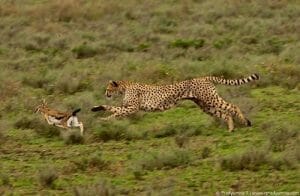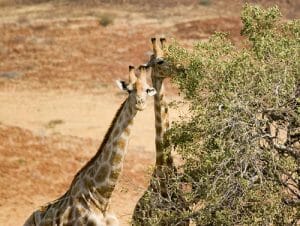Predation Definition
Predation refers to an interaction between two organisms, predator and prey, where there is a flow of energy from one to another. The prey usually suffers a loss of energy and fitness, with a commensurate gain in energy for the predator.
Predation includes carnivory, as well as interactions like grazing, parasitism and symbiotic mutualism. The process of eating seeds and eggs is also considered a form of predation.
The word ‘predation’ derives from the Latin word praedari, meaning ‘to plunder’.
Types of Predation
There are four major types of predation:
Carnivory
Carnivorous predators kill and eat their prey. The common perception of carnivory involves a large animal, such as a lion or a tiger, hunting smaller animals like rabbits or deer. However, carnivorous predation is widespread in the animal world and carnivores can come in a variety of sizes – from sea otters hunting sea stars to blue whales consuming zooplankton, each carnivore is adapted to its mode of feeding.
Herbivory
Herbivorous predation involves the consumption of autotrophs, such as plants or photosynthetic algae. Unlike carnivory, not every herbivorous interaction leads to the death of the plant. Occasionally, herbivory can benefit the plant as well. Fruit seeds are dispersed over wide areas as the herbivore moves. Tough seed coatings are removed in the digestive tract of the herbivore, and its dung fertilizes the soil, providing an ideal environment for seed germination.
Parasitism
Parasitism is a form of predation where the host supplies essential nutrients for the sustained survival and reproduction of the parasite. In many successful parasitic interactions, the host suffers a loss of energy, falls sick or loses access to nutrients. However, unlike carnivory, the host is not always killed. In most cases, the parasite is much smaller than the host.
Mutualism
Mutualism involves the interaction between two organisms where the host provides the nutrition and space for the growth and reproduction of another species. However, the host is not harmed and the interaction is mutually beneficial.
Examples of Predation
Examples #1: Carnivorous Predation
Cheetahs are specialized predators built for stealth and speed. They have excellent camouflage abilities, and powerful muscles that enable them to reach incredibly high speeds in pursuit of their prey. Their strong jaws and sharp teeth help to immobilize the prey and suffocate the animal.
Carnivorous predation can also be an interaction between two groups of organisms. While many carnivores hunt prey that are much smaller than themselves, some cooperate with other individuals of their species to bring down larger prey. A pack of Asiatic wild dogs can pursue and hunt large bison that are nearly 10 times the size and weight of a wild dog.
Carnivorous predation is also seen in the plant kingdom, among insectivores such as pitcher plants and Venus flytraps. Insectivores are often found in regions where the soil is not rich in nutrients.
One exceptional and unusual form of carnivorous predation is cannibalism.
Examples #2: Herbivory
Grazing is a form of herbivory where the plant regenerates the parts that were eaten by the herbivore. Herbivores are adapted to their mode of feeding, with large flat teeth to grind tough plant material. They also contain microorganisms in their gut to digest plant-based carbohydrates.
Plants have been known to develop defenses against grazing. When giraffes feed on acacia trees, the trees release a toxic substance into their leaves that forces the giraffes to move away from them. In addition, the acacias also release ethylene gas, which signals to trees in the vicinity to pump toxins into their own leaves. The herbivores usually move around 300 feet (91 meters) away to resume feeding.
In marine environments, krill are small crustaceans that feed on the primary photosynthetic organism of the ocean – phytoplankton. Krill are crucial to the health of the ecosystem because they are the main food source for large mammals like blue whales.
Examples #3: Parasitism
The parasite that causes malaria, Plasmodium, infects a wide variety of animal hosts – reptiles, birds and mammals – and causes cyclical rounds of high fever and chills. The parasite uses two hosts – one for reproduction and the other for transmission to a new host. In fact, malaria can be so debilitating that its presence can exert an enormous selection pressure on the host. In regions where the disease is endemic, human populations show a surprisingly high incidence of another illness – sickle cell anemia. It appears that individuals who are carriers for this genetic disease have increased survival and reproductive fitness when confronted with malaria.
Tapeworms are common human parasites that can cause malnutrition, especially in young children. Filarial worms are parasites that cause skin, eye and lymphatic diseases.
Parasitism is also seen in the plant kingdom. Strangler figs are common tropical plants that behave like parasites. Many belong to the genus Ficus . Their seeds germinate in the crevices of other trees, and they derive their nutrition by dropping roots into the bark of the host tree, rather than into the soil. Over time, the host tree dies and the strangler fig appears as a tree with a hollow central column.
Examples #4: Mutualism
The interaction between humans and their gut flora is a classic case of mutualism. The bacteria aid in digestion and provide protection against the invasion of pathogenic bacteria. Recent research suggests that the collection of all gut bacteria in an individual can have widespread impact on the host’s metabolism, immunity and well-being.
Similarly, the root nodules of leguminous plants such as chickpea and soybeans, play host to nitrogen fixing bacteria. The bacteria fix atmospheric nitrogen, thereby increasing nutrient availability for the plant. In turn, the plant provides a rich sugar solution to the bacterium.
Trophic Levels
Trophic levels refer to the hierarchical stages in a food chain, starting from autotrophs and moving towards primary, secondary and tertiary consumers. An organism that is a predator at one trophic level can become the prey at a higher trophic level. A herbivore is a predator of plants that becomes prey to carnivores. When sea urchins feed on kelp, they are predators. In turn, they can be consumed by sea otters.
Animals at the top of the food chain are called apex predators. They have no known predators. Often, they play a key role in maintaining the biodiversity of the ecosystems and are considered keystone species. Any changes to their population or density has a wide range of effects on the entire ecosystem.
It is estimated that only 10% of the energy available at one trophic level is available to the predator at the next level. Therefore, most food chains and webs do not have more than three or four trophic levels.
Related Biology Terms
- Apex predators – Organisms at the top of the food chain with no known predators. Examples include lions, tigers, crocodiles, polar bears and killer whales.
- Autotrophs – Organisms capable of using light or chemical energy to form nutritional organic molecules from simple inorganic substances, such as carbon dioxide or methane.
- Crustaceans – A large group of mostly marine invertebrates that includes crabs, shrimp and barnacles.
- Germination – The process by which a quiescent seed grows into a new plant.
- Seed dispersal – The movement of seeds away from the parent plant, to ensure that the seeds receive enough nutrients in order to germinate and grow.
- Territory – The geographical region defended by an organism, primarily for mating and hunting.
Test Your Knowledge
1. Which of these is NOT a form of carnivory?
A. Consumption of eggs
B. Infection by a parasite
C. Consumption of insects by insectivorous plants
D. Hunting of a deer by a pack of wolves
2. Every predator hunts and kills its prey
A. True
B. False
3. Insectivorous plants are carnivores
A. True
B. False
Predation



No comments:
Post a Comment